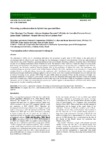Please use this identifier to cite or link to this item:
http://www.alice.cnptia.embrapa.br/alice/handle/doc/1052367| Title: | Flowering synchronization in hybrid rice parental lines. |
| Authors: | MONDO, V. H. V.  NASCENTE, A. S.   NEVES, P. de C. F.   TAILLEBOIS, J. E.   CARDOSO NETO, M. O.   |
| Affiliation: | VITOR HENRIQUE VAZ MONDO, CNPAF; ADRIANO STEPHAN NASCENTE, CNPAF; PERICLES DE CARVALHO FERREIRA NEVES, CNPAF; JAMES EMILE TAILLEBOIS, CIRAD; MANOEL OLIVEIRA CARDOSO NETO, Uni-Anhanguera, Goiânia-GO. |
| Date Issued: | 2016 |
| Citation: | Australian Journal of Crop Science, v. 10, n. 8, p. 1213-1221, 2016. |
| Description: | The cultivation of hybrid rice is a technology that allows for an increase in grain yield of 30% relative to the grain yield of conventional cultivars. However, the main challenge for this technology is related to seed production, which has high production costs and low seed yields. Therefore, agronomic techniques that could enhance flowering synchrony of parental lines in the field are essential for an efficient production system of hybrid rice seeds. The objective of this work was to study the effects of sowing depth, plant density and fertilization with nitrogen or phosphorus as potential techniques to increase the pollen availability in the field and, consequently, the flowering synchrony between parental lines in the production of hybrid rice seeds. The experiments were conducted during two growing seasons in the Central Region of Brazil. All of the experiments were conducted as a randomized complete block in a split plot scheme; however, the experiment with P fertilization had a factorial design. Our research allow inferring that nitrogen fertilization technique applied to the soil or foliar at the time of panicle differentiation does not affect the time of onset of flowering of rice varieties INTA Puitá CL and L106R, which are potential R lines for the production of hybrid rice. Agronomic techniques of variation in sowing depth, seeding rate and the phosphate fertilization affect the time of onset of flowering from 10 to 19 degree-days, which could represent two days in the crop cycle, for the line L106R. Such techniques constitute potential alternatives for use in hybrid rice seed production systems and could be applied in alternated blocks of R lines in the field to obtain longer periods of pollen availability in the field. |
| Thesagro: | Arroz Oryza sativa Floração |
| Keywords: | Arroz híbrido |
| ISSN: | 1835-2707 |
| Type of Material: | Artigo de periódico |
| Access: | openAccess |
| Appears in Collections: | Artigo em periódico indexado (CNPAF)  |
Files in This Item:
| File | Description | Size | Format | |
|---|---|---|---|---|
| CNPAF2016vhvm.pdf | 859.4 kB | Adobe PDF |  View/Open |









